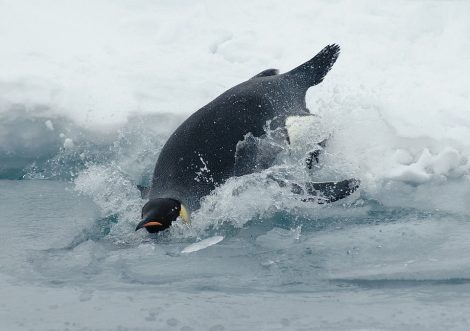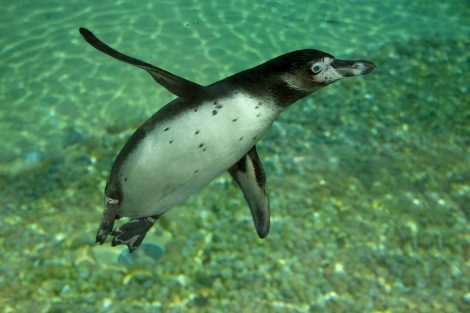Have you ever wondered that how fast can penguins swim?
Well! Penguins are an incredible creation of the god that lives in the southern hemisphere. These aquatic birds have some unusual traits that make them different from the other birds.
You can’t imagine that the penguins can swim more quickly than a human swimmer. Do you want to know that how fast they can swim?
In the below article, you will get to know the answer to all your questions in detail.
Penguin swimming over water
What Is the Swimming Speed of the Penguins in the Water?
Penguins are blessed to have an aerodynamic body outline as well as wings which function like wheels inside the water of the ocean or sea. These seabirds can have a speed of up to 15 mph (i.e., 24 km/hr.) in the water. The average rate of their swimming is in the range of 5mph to 6 mph (i.e., 8 km/hr to 9.6 km/hr) and their walking speed range is between the 1.7 mph to 2.4 mph (2.7 km/hr to 3.8 km/hr).
If you compare the swimming speed of the penguins with the Olympic athletes then you will be surprised to know that the athletes swimming speed can reach around 3.7 mph (5.9 km/hr) while racing inside the water and ideally they can swim approximately 4.5 mph (7.2 km/hr), rendering to a recent research.
Now, let’s explain with you an example!
During the long distances of around 10s to 100s of miles or km, the Adélie Penguins can withstand the speed of approximately five mph or 8 kph. During the short spurts, with the intention of avoiding their catch by chasing prey or leopard seals, penguins can swim 5 to 6 times faster.
Dissimilar to the airborne birds, the wings of the penguins are modified to provide strength on both light strokes of the movement. The bodies of these seabirds are similar to the fish which is fusiform in outline offering low conflict in the water.
Penguins are the best hydrodynamic of entire aquatic creatures. Dissimilar to the dolphins or fish, Adélie Penguins might alter the outline of their body to adapt their speed of swimming. They push their feet nearby to the tail for directing.
How Can the Penguins Swim Faster in the Water?
The penguins can swim quite faster under the water in one single breath. They also porpoise-like the cetaceans while traveling to the long distances. Porpoise is a technique in which the seabird leaps forward but overhead the water with the purpose of inhaling the air along with the fast swimming. It mainly helps them in the inhalation without stopping the forward motion. It is essential for elongated distance swimming.
Penguin swimming underwater
The penguins can jump at the height of 2 m out of the water. Some people think that penguins can do backflips out of the water during the swimming. But that is not true at all. Sometimes the penguins do the backflip only if they misinterpret their landing. However, they don’t relish doing it.
The maximum number of penguin’s species love to do the swimming together, i.e., either in big groups or the smaller groups while searching for the food. Some penguins live most of their time above the water, but they swim underneath the surface and then jump overhead the surface of the water for getting a quick breath.
Some species of penguin like the Gentoos love to swim underneath the water for only 2 minutes and then come out for a small breathing break on the water’s surface for around 40 seconds. With the help of these techniques, the Penguins can swim around 4 miles to 6 miles in one single hour. The rapid divers like the Emperor penguins have an average speed of about 9 miles in one hour.
How the Body of the Penguins Adapted for the Swimming?
The body of the penguin particularly modified for swimming. E.g., penguins usually use their small muscles of the feathers for creating a close-fitting watertight layer. These fluffs are too covered with a distinguished oil to retain the water outwards. The thickness of the feather moreover decreases excess air. Thus the penguin would not float inside the water during the diving or swimming.
Furthermore, the bones of the penguin are relatively weighty. Thus the Penguin shall be weighted and remain underneath the surface. The skeletons neutralize the fat layer of the penguin body which retains it warm however also makes the penguin glide.
The penguin’s wings are more suitable for swimming in comparison to the flying. In reality, their small size wings appear like fins or propellers. However, the penguins utilize these wigs for flying through the water. The lower arms beat at a new fast rate and improved speed. These birds use their healthy developed breast as well as wing tissues for swimming inside the deep water.
The blood of the penguin, especially its hemoglobin, is mainly intended to flow additional quantities of oxygen for the period of swimming. Furthermore, the vast amount of myoglobin is present in the tissues of the muscle for storing the oxygen for inhalation at the bottom of the sea.
What Are the Postures of the Penguins Is the During the Fast Swimming?
The penguins utilize the exceptional postures for swimming in the water. They usually hold their heads close to their shoulders for retaining their body outline compacted inside the sea. Sustaining their feet nearby to the tail too benefits the penguin in navigating during the swimming. While jumping on top of the land, they utilize their webbed feet for stabilizing at the time of a quick shift from the water.
Do the Senses of the Penguins Help Them in the Fast Swimming?
Penguins utilize some senses entirely while swimming. E.g., the vision of the penguin optimized for swimming at the bottom of the sea instead of flying in the sky.
Moreover, the eyes of the birds can distinguish amongst the shades of purples, blues, and greens, which are the colors of seas and oceans. They too possess a minor transparent eyelid for seeing clearly beneath the water. Penguins generally depend on their visualization and their higher sense of audible range to chase for prey and to beat any slayers.
https://www.youtube.com/watch?v=snAvGxz7D04
Conclusion:
To conclude everything from the above article, the average swimming speed of the penguins is between 5mph to 6 mph (i.e., 8 km/hr. to 9.6 km/hr.) which is outstanding. It is quite quick than a human swimmer. Fast swimming helps them in catching their prey quickly and also keeps them safe from the danger of any predator.
Are you interested in knowing more about these beautiful creatures? Then, please write to us here. We will provide you with lots of informative articles on these seabirds that you will not find on any other website for sure.
Thanks for being with us on this journey!
References
http://www.nydailynews.com/news/world/mystery-penguin-fast-swimming-discovered-article-1.1188268
https://prezi.com/_lsrsadatvzf/why-do-penguins-swim-so-fast/
https://www.ncbi.nlm.nih.gov/pmc/articles/PMC2842743/
Image Source:

